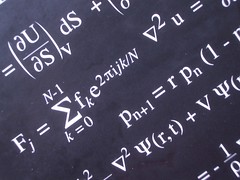 |
I have placed a preprint on the arXiv ‘Killing sections and sigma models with Lie algebroid targets’ (arXiv:1506.07738 [math.DG]). In the paper I recall the notion of a Riemannian Lie algebroid, collect the basic theory and proceed to define Killing sections. |
Lie algebroids are a generalisation of the tangent bundle of a manifold. The mantra here is that whatever you can do on a tangent bundle you can do on a Lie algebroid. This includes developing a theory of Riemannian geometry on them.
The notion of a Riemannian metric on a Lie algebroid is just that of a metric on the underlying vector bundle. There is no compatibility condition or anything like that. So, as all vector bundles can be equipped with metrics, all Lie algebroids can be given a metric. The interesting fact is that the Lie algebroid structure allows you to build the theory of Riemannian geometry in exactly the same way as you would on a standard Riemannian manifold. A Lie algebroid with a metric are known as Riemannian Lie algebroids.
In particular we have a good notion of torsion (which is generally missing) and have the notion of a Levi-Civita connection. Moreover, we have the fundamental theorem that says that such a connection is uniquely defined by metric compatibility and vanishing torsion, just as we have in the classical case. All the formula generalise directly with little fuss.
This all begs the question of developing general relativity on a Lie algebroid. Indeed one can formulate the Einstein field equations in this context, see [1]. The geometry here is clear and very neat, the applications to the theory of gravity are less clear.
Killing sections
Something I noticed that was generally missing in the literature was the notion of a Killing section of a Riemannian Lie algebroid. Such a section is a natural generalisation of a Killing field on a Riemannian manifold; they represent infinitesimal isometries. In the paper I show how the basic idea generalises to Riemannian Lie algebroids giving the notion of a Killing section. Moreover, I show how the common ways of expressing the notion of a Killing field directly generalise to Lie algebroids.
Sigma models and harmonic maps
With the above technology in place, I then look at the theory of sigma models that have a Riemannian Lie algebroid as their target. I took the work of Martinez [2] on classical field theory on Lie algebroids, and applied it to this class of theories. The basic idea is that the fields of such a theory are Lie algebroid morphisms from the tangent bundle of our source manifold to a Lie algebroid target. Equipping both the source and target with a metric allows us to build a model in exactly the same way as a standard sigma model on the space of maps between two Riemannian manifolds. The critical points of the Lie algebroid sigma model are seen to be a generalisation of harmonic maps.
I show, as expected, that the infinitesimal internal symmetries of the Lie algebroid sigma model are described by the Lie algebra of Killing section.
After thoughts
Non-linear sigma models represent a large class of models that have found applications in high energy physics, string theory and condensed matter physics. From a mathematical perspective, sigma models provide a strong link between differential geometry and field theory. In this work, I do not attempt to find such applications of the Lie algebroid sigma model, I focus on the differential geometry. However, studying such models seems very natural and hopefully useful.
References
[1] M. Anastasiei & M. Girtu, Einstein equations in Lie algebroids, Sci. Stud. Res. Ser. Math. Inform. 24 (2014), no. 1, 5-16.
[2] E. Martinez, Classical field theory on Lie algebroids: variational aspects, J. Phys. A: Math. Gen. 38 (2005) 7145.

